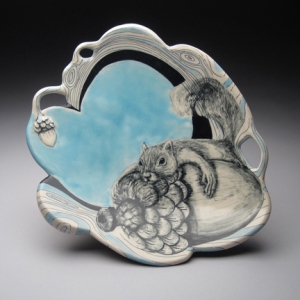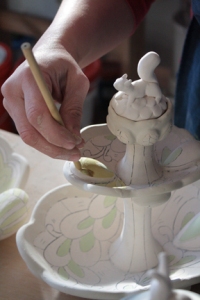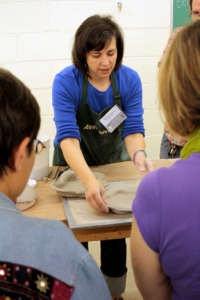For the month of April…to help ring in spring…Chandra DeBuse!
Chandra and I met at Arrowmont School of Arts and Crafts a couple years ago. Before we met, I was flipping through Ceramics Monthly magazine and stumbled on images of Chandra’s work. I was immediately struck by her playful pots and imagined how fun they would be to use. Her work is charming and cheerful, witty and whimsical. Most importantly, the pieces I own put a smile on my face everyday.
Here’s a sneak peek of some of Chandra’s upcoming events and where you can find a piece of hers for your very own:
To celebrate spring, Chandra will post a virtual kiln opening of new work on her Etsy site (DeBuse Ceramics) May 15th. Also in May (4-5), she will be at Baltimore Clayworks for a two-day workshop. July 27th, Chandra will conduct a one-day workshop at Red Star Studios in Kansas City and in September (20-22), she will present her work and her processes at the Handbuilt Conference for CERF in Philadelphia.
For additional information, please visit Chandra’s website: www.chandradebuse.com
Enjoy the interview!
How did you first get involved in ceramics?
My early experience with ceramics was most definitely NOT love at first sight. I was drawn to the responsiveness of soft clay, but I lacked the discipline necessary to have any kind of success during my undergraduate ceramics class. Fast forward a few years—I was working a stressful job and I needed a creative outlet, so I took a community clay class. By that time, I had matured and gained discipline and everything clicked. I couldn’t get enough.
What made you choose to attend a post-bacc program in ceramics? Can you talk a little bit about how that decision impacted your career path?
Going back to school after I had been working in clay for 8 years was a game-changer. I had been gaining knowledge through community classes, books, magazines and workshops but I was really hungry to know more and academia seemed like a logical next step. I took two clay classes at the University of Nebraska-Lincoln before applying to their post-bacc program. Just being in the university environment helped me understand the culture of academic clay, filled in some gaps in my education and helped me start to think critically about my work. The encouragement and generosity of the faculty, graduate students, and my peers helped me to sort out my vision for my own future. As a special student, I was at an advantage because I was paying in-state tuition so I took some extra classes: an art history survey course, kiln building, and sat in on the graduate seminar, while working on my portfolio and applications to graduate school. Being a special student was like being inside a magical bubble where I had a lot of opportunity and not a ton of responsibility. Seeing how another program’s graduate department operated gave me insights that helped me navigate my own graduate school experience. Oh yeah, and I made some good friendships that continue to this day.
With a background in psychology, how did you decide to pursue a Master’s degree in Ceramics?
I have always had fluid ideas of career and education and some days I even ponder what I’ll study next. After working in human services and nonprofit administration, I was ready for a career change, although I was not entirely sure where my MFA would lead. I always felt that my undergraduate degree just scratched the surface of the field of psychology and I kept searching for a deeper understanding of the human experience. That quest led me to making pottery and continues in the work I make today.
How do you feel that your formal education (including your psychology degree) prepared you for your career in ceramics?
The practical on-the-job experience I gained between undergrad and grad school developed my skills in mediation, listening, problem solving, communication, record keeping, grant writing/reporting, time management, personnel management and statistics. I definitely drew upon those skills during graduate school and I have used every one of those skills as a potter! I feel that the life I lived before I found clay gives me not only appreciation but also a perspective that grounds me.
My work is much stronger because I went to graduate school. Formal education taught me how to continue asking questions and improving on my ideas. I also grew to understand how educating others through direct teaching and presentation aids my own artistic
development. The support I have received from the University of Florida ceramics community during school and since graduation has without a doubt pushed my career forward.school developed my skills in mediation, listening, problem solving, communication, record keeping, grant writing/reporting, time management, personnel management and statistics. I definitely drew upon those skills during graduate school and I have used every one of those skills as a potter! I feel that the life I lived before I found clay gives me not only appreciation but also a perspective that grounds me.
How would you describe your work? How did you arrive at working this way?
I make voluminous pots that incorporate narrative hand-drawn imagery and pattern, candy colors, and bouncing lines to impart a sense of play. Because I learned about pottery-making in a relaxed community pottery studio, on my own terms, outside of an academic agenda, I approached clay in a very playful way. I trained myself to play with clay for 8 years before learning to think conceptually about pottery. This shift in thinking was painful for me and I’m pretty sure it was painful for my instructors too. My early forms and surfaces weren’t cohesive. Working narratively is a straightforward way of communicating ideas. I always loved drawing, but I didn’t seriously try drawing on pots until the summer

Catch Platter, 2010
before my thesis year. It all started with squirrels, which were always right outside the studio window. Squirrels are just like students: they are impulsive and obsessed with a goal. A metaphor was born.
What is the inspiration for your pieces? How do you come up with new ideas? Can you walk us through your creative process when coming up with new forms/ideas?
My thesis installation was a retelling of my own graduate school experience: a playful story of achievement through the eyes of a squirrel. After grad school, I continued working under the same larger themes of play and achievement, but started working through different stories with different characters and landscapes.
The process of play remains an important part of my studio practice. My formula for creative play is: low risk + high novelty. Ideas are born in my sketchbook. I’ll start with a doodle, turn that doodle into a character and think about the struggle that character is involved in. I add details to the drawing, play with composition, edit down, and relate the story to the landscape of a vessel. I throw forms on the wheel and handbuild, using soft slabs with molds that I generate out of clay, plywood and/or craft foam. These inexpensive materials are easy for me to customize and quickly work through ideas about shape and form. Even as a novelty junkie, I do believe that great pots are born from discipline and repetitive practice, looking with a critical eye and making adjustments for the next round.
I’ve always been attracted to your use of the narrative. What comes first, story or form?
It depends on what I’m working on. I use cups and plates to try out a lot of narratives, so the stories might change, but the forms stay the same. My loose narratives are based on larger themes, such as achievement or play. These larger themes tie my work together. Casual observers may not make the connections between the pieces, but for me, they are all related. The tiered treat server forms were conceived while I was developing my thesis. The tiered forms tell the story of desire, as it relates to achieving a goal and reaching the reward. When I include a character on a treat server, such as a snail or squirrel, they are involved in that struggle of getting to the highest tier. The function of the server, to hold treats, is conceptually relevant to the story too. It is much different than if I were designing a server for fruits and vegetables. The result is a piece with layers of meaning.
I know that you’ve moved around a bit post-graduate school. Could you describe some of the most influential or career changing experiences you’ve had?
Being a resident artist at Arrowmont School of Arts and Crafts (Gatlinburg, TN) was pretty special. The national summer workshop programming provided me with opportunities to meet renowned artists (like you!), host visitors in my studio, and give weekly public powerpoint presentations about my work. There aren’t too many places that offer that kind of exposure. I knew that continuing the momentum built during graduate school would depend on making a lot of work and finding an audience for my work. I was lucky to land in two year-long residencies (Armory Art Center in West Palm Beach, FL and Arrowmont) that provided financial stipends and allowed me to devote the majority of my time to my artistic practice.
Being recognized as one of six emerging artists at the 2012 NCECA conference, being named an Emerging Artist in Ceramics Monthly magazine and delivering an NCECA-sponsored lecture during SOFA Chicago made 2012 a remarkable year. This happened as I was preparing to make a transition to being a full-time studio potter. The exposure certainly hasn’t hurt. 2013 has some big shoes to fill though.
Kansas City is a hotbed for ceramics. Not only is it home to the Kansas City Art Institute, Nelson-Atkins Museum, Sherry Leedy Gallery, Red Star Studios, etc., but there are many private studios maintained by internationally recognized ceramic artists (like yourself) in the area. Now that you’ve settled and set up a studio, can you describe what attracted you to Kansas City?
It IS a hotbed! There are countless benefits to living in a city with such a thriving clay and arts community. Since moving here, I taught a community class at Red Star Studios, presented to the KC Clay Guild, and I am currently an instructional assistant at the Kansas City Art Institute. My boyfriend Tommy, the Studio Manager at Red Star Studios, has done a lot to keep me connected to the arts community here. If not for him, I would probably hole up in my studio way too much.
After living in some remote areas, I can really appreciate the access that Kansas City offers. I live a mile from Crane Yard Clay, which sells studio materials and supplies, there is even a packaging supply distributor where I can drive over and load the truck with bulk shipping materials, there’s a really cheap place that sells clean scrap upholstery foam. No more harvesting foam from nasty side-of-the-road couches! There are some really great restaurants (not just bbq!). When I moved here, I had a full calendar of show obligations, so I needed to set up a studio quickly. I chose to rent studio space in a quieter place near the arts district. The cost of living is moderate and I grew up just a few hours north of here, so Kansas City feels like home.
Was there a point in your career that you made a decision to sell your pots for a living? Could you describe how you came to that decision?
That decision is evolving. After graduate school, I wanted to spend 3-5 years primarily focusing on my artwork in an effort to build on the momentum I gained during school (I am in year 3). As it happened, I spent the first two years in artist residency programs. While at Arrowmont, I began to find an audience for my work and started a mailing list to keep connected to the hundreds of people I met. I have been working as an independent studio potter since last July, piecing together my income from selling pots, teaching and doing workshops. It has been stressful at times and I have not got the pie chart of income figured out yet. There is much tweaking to be done with price points and time investments. I am still pretty open-minded about opportunities that take me out of my studio, as long as they present chances for income, learning, and still leave room for me to make pots.

Squirrel Treat Server in process, 2013
What does a typical workday look like for you? How much do you spend on marketing vs. making?
I have yet to find “typical.” So far, deadlines have driven my time. Last summer and a little bit this fall, I was spending 14 hour days in the studio, preparing for shows. Teaching, traveling, packing and shipping work, taking photographs, applying for things and writing articles have taken me out of the studio. When I’m out of the studio, such as doing a workshop or setting up a show, I try to be mindful of marketing opportunities. A snapshot of me teaching a workshop posted to the web on my blog or facebook page tells my story and serves as a marketing tool. It not only connects with my audience, but defines who I am and what I have to offer. Working with other organizations, such as AMACO and Northern Clay Center has resulted in media that has expanded my audience.
How does an artist go about acquiring business and marketing skills? What piece of advice would you give to others just starting out?
Marketing efforts should reflect your brand identity, which should be cohesive with your artist statement. If you want organizations to invite you to do workshops, make sure that your online content reflects that. Share pictures of yourself giving workshops, record a little video demo and put it on Youtube. Write a how-to article for a ceramics publication, present at NCECA. If there is a product you love and use in your studio practice, reach out to the manufacturer and let them know. It may lead to some kind of partnership that can lend exposure to your work. There are many ways to tackle the marketing monster, but it’s all about finding your audience and creating opportunities.
There is a mythology surrounding a potter’s life and marketing efforts tend to lean toward, “crafting the mythology.” I think there is a lot of truth to this, especially since it doesn’t make much business sense to promote an image of failure—even if that’s the reality. Those who are actually making and selling their work and making a living are exceptionally disciplined and resourceful. I have my eye on those people and I try to learn as much as I can from the ways they have structured their businesses.
What is your relationship with galleries (on and offline)? How has that relationship changed over time?
The internet is really changing the gallery/artist/collector relationship. Well-respected galleries are able to reach a wider audience and lend credibility to emerging artists. I prioritize galleries who have both a physical gallery and an online presence. It is imperative that galleries selling online represent my work through beautiful displays, photographs and provide promotional materials, including catalogs, posters, print mailings and social media. As my work has become more visible in the past year, keeping galleries stocked with inventory has been challenging. David Trophia of Crimson Laurel Gallery in Bakersville, NC recently offered advice to “under-promise” and “over-deliver.” It’s good advice and my mantra for 2013.
Although I want to maintain excellent relationships with galleries, the traditional gallery model of sales is not feasible as my only source of income. Commissions, cost of studio rental, materials, labor, shipping and taxes eats away the profits of making time intensive work like mine. I am currently researching opportunities to increase the potential for direct sales.
I know that you have an Etsy site where you sell your wares. Can you briefly describe your Etsy experience?
My Etsy site (DeBuse Ceramics) has been open for 8 months. Most of my sales through Etsy have been with people who are already familiar with my work. The biggest challenge for me has been to allocate work to my Etsy site instead of sending it to other venues. When you look at pure profit, it may seem like a no-brainer to focus on direct sales, but maintaining gallery relationships is a tremendous benefit. My business plan includes increasing my Etsy listings. I will be launching a virtual kiln opening on May 15th on my Etsy site, where I will be listing 30 new pieces celebrating spring.
Finally, what advice can you give aspiring artists struggling to find their own voice/style?
Collect what interests you in a sketchbook or binder. Make a lot of work. Seek feedback from people you respect. Experiment with other solutions. Allow yourself to play. Write about your work often (what are the pieces communicating? How are they doing that? How could they say it better?). For me, giving a 5-10 minute power point presentation about my work always helps me to condense my ideas and verbalize my intentions. More often than not the process of preparing a presentation leads to new ideas and gives my studio practice a kick in the pants.
For more info about Chandra and her work, please visit her website: www.chandradebuse.com
And…here’s a shortlist of what Chandra’s up to these days:







